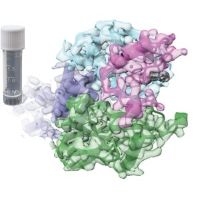Specification
| Organism | Homo sapiens (Human) |
| Expression Host | E.coli |
| Tag Info | N-terminal GST-tagged |
| Purity | Greater than 85% by SDS-PAGE |
| Uniprot ID | Q96FW1 |
| Gene Names | OTUB1 |
| Alternative Names | Deubiquitinating enzyme OTUB1OTU domain-containing ubiquitin aldehyde-binding protein 1Otubain-1 ;hOTU1Ubiquitin-specific-processing protease OTUB1 |
| Expression Region | Partial(2-201aa ) |
| Molecular Weight | 50.1 kDa |
| Protein Sequence | AAEEPQQQKQEPLGSDSEGVNCLAYDEAIMAQQDRIQQEIAVQNPLVSERLELSVLYKEYAEDDNIYQQKIKDLHKKYSYIRKTRPDGNCFYRAFGFSHLEALLDDSKELQRFKAVSAKSKEDLVSQGFTEFTIEDFHNTFMDLIEQVEKQTSVADLLASFNDQSTSDYLVVYLRLLTSGYLQRESKFFEHFIEGGRTVK |
| Form | Liquid or Lyophilization |
| Buffer | The default storage buffer is Tris/PBS-based buffer, 5%-50% glycerol if the delivery form is liquid. The lyophilization buffer is Tris/PBS-based buffer, 6% Trehalose, pH 8.0 if the delivery form is lyophilized powder. Please contact us if you have any special requirment. |
| Reconstitution | Please reconstitute protein in deionized sterile water and we recommend that briefly centrifuge thevial prior to opening the vial .We recommend aliquot for long-term storage at -20℃/-80℃. |
Background
| Relevance | Hydrolase that can specifically rove 'Lys-48'-linked conjugated ubiquitin from proteins and plays an important regulatory role at the level of protein turnover by preventing degradation. Regulator of T-cell anergy, a phenomenon that occurs when T-cells are rendered unresponsive to antigen rechallenge and no longer respond to their cognate antigen. Acts via its interaction with RNF128/GRAIL, a crucial inductor of CD4 T-cell anergy. Isoform 1 destabilizes RNF128, leading to prevent anergy. In contrast, isoform 2 stabilizes RNF128 and promotes anergy. Surprisingly, it regulates RNF128-mediated ubiquitination, but does not deubiquitinate polyubiquitinated RNF128. Deubiquitinates estrogen receptor alpha (ESR1). Mediates deubiquitination of 'Lys-48'-linked polyubiquitin chains, but not 'Lys-63'-linked polyubiquitin chains. Not able to cleave di-ubiquitin. Also capable of roving NEDD8 from NEDD8 conjugates, but with a much lower preference compared to 'Lys-48'-linked ubiquitin.Plays a key non-catalytic role in DNA repair regulation by inhibiting activity of RNF168, an E3 ubiquitin-protein ligase that promotes accumulation of 'Lys-63'-linked histone H2A and H2AX at DNA damage sites. Inhibits RNF168 independently of ubiquitin thioesterase activity by binding and inhibiting UBE2N/UBC13, the E2 partner of RNF168, thereby limiting spreading of 'Lys-63'-linked histone H2A and H2AX marks. Inhibition occurs by binding to free ubiquitin: free ubiquitin acts as an allosteric regulator that increases affinity for UBE2N/UBC13 and disrupts interaction with UBE2V1. The OTUB1-UBE2N/UBC13-free ubiquitin complex adopts a configuration that mimics a cleaved 'Lys48'-linked di-ubiquitin chain. |
| Involvement in Disease | |
| Subcellular Location | Cytoplasm |
| Protein Families | Peptidase C65 family |
| Tissue Specificity | OTUB1 |
QC Data
| Note | Please contact us for QC Data |
| Product Image (Reference Only) |  |

